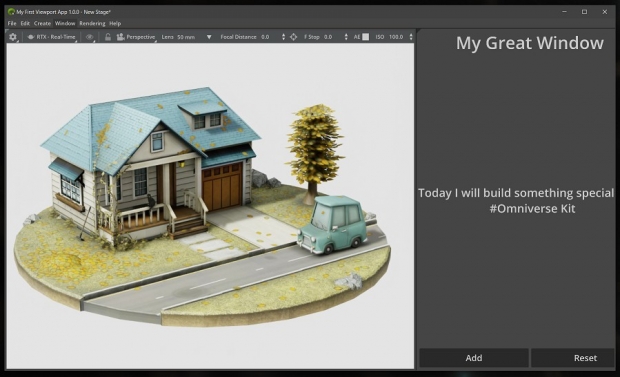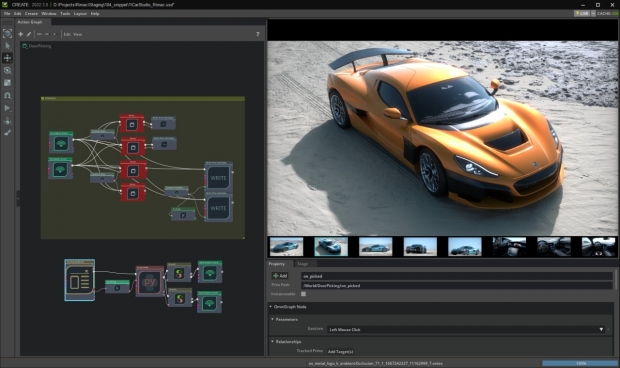Major updates to core reference apps and tools offer increased speed, accessibility, and flexibility for collaborative workflows, making it easier for developers, creators, and novices to build metaverse applications.
NVIDIA Omniverse’s newest beta release is now available, with major updates to core reference applications and tools for developers, creators, and novices looking to build metaverse applications, with each core component updated with increased speed, accessibility, and flexibility for collaborative workflows across applications. Powered by support for new Ada Generation GPUs and advances in NVIDIA simulation technology, the release focuses on maximizing the ease of ingesting large, complex scenes from multiple third-party applications and maximizing real-time rendering, path tracing, and physics simulation.
Nucleus, the central database and collaboration engine of Omniverse, enables faster live collaboration and copying between servers. Nucleus Navigator 3.2 allows for seamless file and folder movement between servers on-premises and in the cloud. It also enhances search functionality to retrieve images, objects, and other assets quickly. In addition, OmniObjects with Omniverse Live 2.0 allows faster collaboration between Connectors.
New and updated Connectors for popular apps are available through Omniverse Connect. The libraries allow users to create Connectors from their favorite apps to the Omniverse platform. The beta release includes new and updated Connectors for PTC Creo, Autodesk Alias, Kitware ParaView, Siemens JT, and Autodesk Maya.
PhysX 5, the flagship tool of Omniverse Simulation, has been open sourced to easily modify, build, and distribute users’ own physics simulation applications. In addition, the new version of PhysX has features support for multiple scenes, collision-triggered audio, and an inspector for robotic applications.
Omniverse Kit 104 drives new features and capabilities across Omniverse applications, allowing novice or experienced Python and C++ developers to develop, package, and publish their own custom metaverse applications and extensions to accelerate industry-specific workflows more easily.
Connecting to Omniverse with USD
NVIDIA’s software partners are building useful extensions and Connectors on Omniverse Kit. Some of the more recently published extensions and Connectors include:
- Updates to Omniverse Connectors for Autodesk 3ds Max, Autodesk Maya, Autodesk Revit, Epic Games’ Unreal Engine, McNeel Rhino, Trimble SketchUp, Graphisoft Archicad, and Kitware’s ParaView
- New Omniverse Connectors for Autodesk Alias and PTC Creo
- Reallusion iClone 8.1.0 live sync Connector for seamless interactions between Omniverse apps and iClone 8
- The OTOY OctaneRender hydra render delegate, which enables Omniverse users to use OctaneRenderer directly in the Omniverse Create or View viewport
- The Nextspace digital twin platform extension for normalizing data and geometry to drive the use of AI, analytics, and simulation
- SmartCow’s Omniverse extension for synthetic data generation of large datasets of license plates for license plate recognition AI
More extensions and Connectors are on the way from companies like Lumirithmic, who is connecting their Hollywood-grade avatar scan provider to Omniverse.
“We've been using NVIDIA Omniverse as our primary content delivery engine to serve our enterprise customers,” said Jayanth Kannan, VP of Software Engineering at Lumirithmic. “NVIDIA Omniverse does all the heavy lifting and enables seamless integration of our Avatars with industry-standard DCC tools, helping our customers readily use our assets in their commercial projects.”
Move.ai, another partner extending the Omniverse, will soon publish an extension to put markerless motion capture in the hands of Omniverse users.
"We're excited by the potential to enable users to enhance their creative pipelines with our Move extension, which will allow users of Omniverse to access our free Motion Library," said Niall Hendry, Head of Partnerships & Delivery at Move.ai. "The Omniverse team has been super responsive, guiding us every step of the way."
Developers can apply for early access to the new Omniverse Exchange Publishing Portal, which offers a new channel to distribute their custom tools and applications – additional information is available here.
A new foundation for developing metaverse tools with Omniverse Kit 104
Omniverse Kit is the SDK on which every Omniverse microservice (like DeepSearch) or reference application (such as Omniverse Create, View, or Isaac Sim) is built. These microservices and reference applications are samples for developers to copy and customize.
Most Omniverse development work is exposed in Python workflows. This Omniverse Kit 104 beta release includes a new set of extension templates for C++ developers and technical artists to build extensions using C++.
Templates in GitHub contain various example extensions to act as references for developing UI widgets, Universal Scene Description (USD) interactions, and more. These templates remove the need to create extensions from scratch and speed up application development.
New Omniverse Kit app templates are now available on GitHub, making it easier to build advanced 3D tools like NVIDIA’s reference applications that leverage core Omniverse technologies like RTX, PhysX, OmniGraph, and USD.
Other key updates in Omniverse Kit include:
- Viewport 2.0 for fully customizable, open workflows
- New navigation possibilities for user interfaces in Omni.UI.Menu
- The ability to encapsulate extension features in Actions
- A centralized API and UI to manage Hotkeys
 See Kit 104 in action with Omniverse reference applications
See Kit 104 in action with Omniverse reference applications
Omniverse Code is the integrated development environment (IDE) where developers can access the new features of Kit 104. The latest documentation and samples for building Omniverse applications, extensions, and microservices are integrated into Omniverse Code so developers of all backgrounds can learn to develop and use Kit extensions. In addition, Omniverse Code makes it easier to leverage Omniverse’s extensibility so non-traditional developers can quickly build tools and applications to make their workflows more efficient and personalized.
The updated Omniverse Create application is part of the beta release with usability improvements, new PhysX tooling, and better capabilities for large-world authoring. Creators can collaborate more seamlessly on large worlds with layer-based live workflows and Viewport icons showing the locations of other users in a scene.
This release also supports the new DLSS 3 included in the Ada Generation GeForce RTX and NVIDIA RTX GPUs, enabling massive improvements in performance and quality in the RTX renderer by generating additional high-quality frames in real-time.
New PhysX extensions for Omniverse Create include:
- PhysX Authoring Toolbar - A simple authoring toolbar to make all your content behave correctly in a simulated environment
- Signed Distance Field (SDF) Colliders - SDF based collision detection can now be used for physics objects, enabling direct real-time simulation of gears and cams
This year, Create has launched over 300 extensions built in Kit, including:
- ActionGraph - The special OmniGraph in Create allows the creation of event-driven behaviors and logic inside scenes with node-based visual programming.
- Omni.ui.scene - An extension in Omni.ui for building interactable UI for widgets and manipulators directly inside the viewport or 3D environment.
- DeepSearch - an AI-powered microservice that enables instant natural language or 2D image-based search into Omniverse Nucleus’s asset database to retrieve images, objects, or other assets.
“For architectural design/visualization workloads, normally we use software out of the box, but you can run into limitations with those out-of-the-box implementations,” said Eric Craft, XR & Visualization Program Manager at architectural firm Mead & Hunt. “NVIDIA’s Omniverse development platform gives me the ability to easily tweak and customize their tools, so I can build a more efficient, more effective toolkit for our company.”
“Since it’s based on USD,” added Craft, “the platform interconnects with other popular industry tools, which means I can build a custom Omniverse tool in one place but use it across our multi-app workflows. And because of the USD layer-based workflow changes in Omniverse stay even when the design export is updated.”
Audio2Gesture, an AI-powered tool that creates realistic body gestures based on an audio file, is now available in Omniverse Machinima.
Omniverse View, a simple review and approval app, now features a focused, collaborative review and markup experience.
Omniverse Replicator, an SDK for generating 3D synthetic data for AI and simulation workflows, is now available as a container for easy deployment on your preferred Cloud Service Provider (CSP). AWS users can leverage the Omniverse GPU-Optimized AMI available on the AWS marketplace and deploy the replicator container seamlessly on their EC2 instance.
Download the Omniverse free license for individuals here.
Source: NVIDIA










